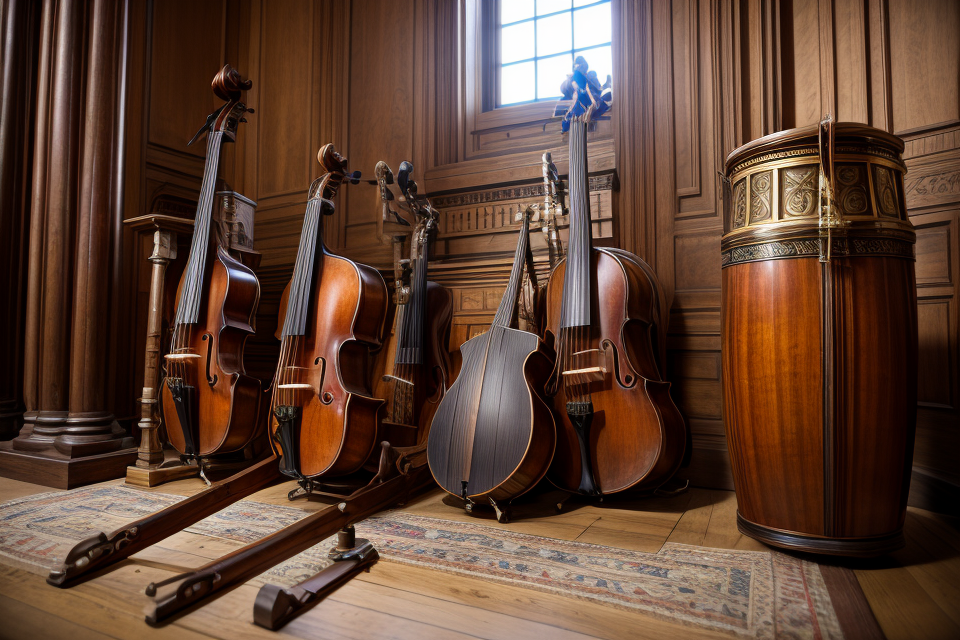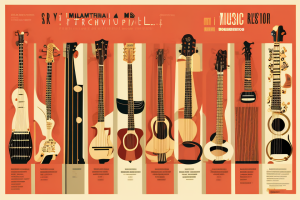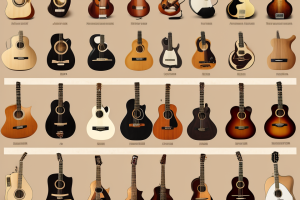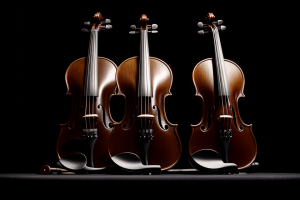
Have you ever wondered about the oldest instruments in the world? Music has been a part of human culture for thousands of years, and throughout history, people have used various tools to create beautiful melodies. From ancient civilizations to modern times, music has played a significant role in human society. In this article, we will explore the two oldest instruments known to mankind and learn about their fascinating history. Get ready to discover the instruments that have been around for thousands of years and continue to captivate us today!
The oldest known musical instruments in the world are believed to be bone flutes, which were discovered in the caves of southwestern Germany and dated back to around 40,000 years ago. These flutes were made from the hollow bones of birds, and were capable of producing a range of sounds and melodies. Other ancient instruments include the lute, which was popular in medieval Europe, and the sitar, which is still played in India today. These instruments have been used for thousands of years to create music and express emotion, and continue to be an important part of many cultures around the world.
The History of Musical Instruments
The Evolution of Music
Throughout history, music has played a significant role in human societies, serving as a form of expression, communication, and entertainment. The evolution of music is a fascinating subject that has been shaped by various factors, including cultural influences, technological advancements, and societal changes.
One of the earliest forms of music can be traced back to prehistoric times, where humans used simple instruments such as bone flutes and drums made from hollow logs. These instruments were often used in rituals and ceremonies to communicate with the spirit world and to mark important events in people’s lives.
As civilizations began to develop, music evolved alongside other forms of art and culture. Ancient Egyptians, for example, are known to have used a variety of instruments in their religious ceremonies, including harps, lyres, and tambourines. Similarly, ancient Greeks used instruments such as the aulos, a reed instrument similar to a modern-day clarinet, and the lyre, a stringed instrument that was played with a plectrum.
During the Middle Ages, music continued to evolve, with the emergence of new instruments such as the lute and the recorder. These instruments were used in court and church music, and were often played by professional musicians.
The Renaissance period saw a significant expansion in the types of instruments available, with the invention of the piano, the violin, and the cello. These instruments were used in the composition of complex and sophisticated music, and helped to establish the classical music tradition that continues to thrive today.
In the modern era, music has continued to evolve and diversify, with the development of new technologies and styles. From electronic dance music to hip-hop and pop, the range of instruments and sounds used in music today is almost limitless.
The Importance of Musical Instruments
The Importance of Musical Instruments
Throughout history, musical instruments have played a significant role in human societies, serving as a means of expression, communication, and entertainment. The oldest instruments in the world offer a glimpse into the past and provide insights into the evolution of music and its significance in different cultures.
In ancient civilizations, musical instruments were often used in religious rituals and ceremonies, symbolizing spiritual and cultural values. These instruments were also used to express emotions and tell stories, serving as a form of oral history. The use of musical instruments in social gatherings helped to bring people together, promoting a sense of community and unity.
In addition to their cultural and social significance, musical instruments have also played a role in scientific and technological advancements. The study of musical instruments has led to the development of new materials, technologies, and techniques, influencing the design and construction of other tools and devices.
Furthermore, the appreciation and study of the oldest instruments in the world provide opportunities for cultural exchange and education, helping to preserve and celebrate the diversity of human creativity and ingenuity.
The First Instruments
The earliest known musical instruments date back to the Paleolithic era, over 40,000 years ago. These instruments were simple, yet sophisticated, and were used for ritualistic and ceremonial purposes.
One of the earliest known instruments is the bone flute, which was discovered in the cave of the Trois-Fosses in France. This flute is made from a bird’s wing bone and has five finger holes, suggesting that it was played with a precise technique similar to that of modern flutes. Carbon dating has placed the age of this flute at around 40,000 years old.
Another early instrument is the bear bone rattle, which was also found in the Trois-Fosses cave. This instrument was made by scraping the bone of a bear to create a hollow, then filling it with small stones or pebbles to create a rattling sound. The bear bone rattle was likely used in shamanic rituals and ceremonies.
Other early instruments include the drum, which has been found in many ancient cultures, and the whistle, which is a simple instrument made by blowing air through a narrow tube or across a small opening. These instruments were likely used for communication, entertainment, and religious purposes.
Overall, the first instruments were simple, yet sophisticated, and played an important role in the cultural and spiritual lives of early humans.
The Oldest Instruments in the World
Humans have been creating musical instruments for thousands of years, and throughout history, there have been many different types of instruments developed. Some of the oldest instruments in the world have been found in various parts of the globe, and they provide insight into the early development of music.
One of the oldest instruments in the world is the hurrian flute, which was discovered in the ancient city of Ur in modern-day Iraq. The flute is believed to be over 4,000 years old and is made from the bone of a bird. It has six finger holes and a V-shaped mouthpiece, and it is believed to have been played by the ancient Sumerians.
Another ancient instrument is the Lur, which is a bronze trumpet that was used by the ancient peoples of what is now modern-day Iran. The Lur is believed to be over 2,500 years old and was used in religious ceremonies and for military purposes. It is made from a single piece of bronze and has a distinctive sound that is still used in traditional Persian music today.
The Djembe is another ancient instrument that is still widely used today. The Djembe is a type of drum that is native to West Africa and is believed to be over 3,000 years old. It is made from a hollow wooden body and a goat skin head, and it is played with the hands. The Djembe has a deep, resonant sound and is an important part of many traditional African music styles.
The Mbira, also known as the thumb piano, is a musical instrument that is native to Africa and is believed to be over 1,000 years old. It is made from a small wooden board with metal strips attached to it, and it is played by plucking the strips with the thumbs. The Mbira has a distinctive, ethereal sound and is an important part of many traditional African music styles.
Overall, these ancient instruments provide a fascinating glimpse into the early development of music and demonstrate the important role that music has played in human culture throughout history.
How They Were Discovered
Experts have been fascinated by the discovery of musical instruments that date back to ancient civilizations. Many of these instruments were found in archaeological digs, such as the ancient Sumerian city of Ur, where a lyre dating back to 2500 BCE was discovered. Other instruments, such as the flute found in the famous “Ice Princess” burial site in Siberia, date back even further to around 2000 BCE. These discoveries have provided valuable insights into the history of music and the development of musical instruments over time.
Flute
The flute is one of the oldest musical instruments known to mankind, with evidence of its existence dating back over 40,000 years. It is believed that the first flutes were made from the bones of birds, such as swans or geese, and were used in rituals and ceremonies by early human societies.
The earliest known flutes were discovered in the caves of Europe and Asia, and were made from the hollow bones of large birds. These flutes were small, simple, and had only three or four fingerholes. Despite their simplicity, they were capable of producing a range of musical notes, and were likely used in religious and spiritual ceremonies.
Over time, the flute evolved and improved, with the addition of more fingerholes and the use of different materials, such as wood and bamboo. The ancient Greeks and Romans also made use of the flute, and it became a popular instrument in classical music.
Today, the flute remains an important instrument in classical music, and is also used in a variety of other genres, including jazz and popular music. Its unique sound and versatility have made it a beloved instrument among musicians and music lovers alike.
The Significance of Flutes in Ancient Cultures
Flutes are some of the oldest musical instruments known to mankind, with evidence of their use dating back over 40,000 years. These ancient instruments were made from a variety of materials, including bone, wood, and even animal horns.
Flutes were highly valued in many ancient cultures, as they were believed to have a powerful connection to the spirit world. In many Native American cultures, for example, flutes were played during spiritual ceremonies and were believed to have the power to heal and bring about positive change.
Flutes were also used in ancient Greek and Roman cultures, where they were played during religious ceremonies and performances. The Greek philosopher Plato even wrote about the importance of music in education, stating that it had the power to “purify the mind.”
Today, flutes continue to be an important part of many traditional cultures around the world. They remain a symbol of the connection between humans and the natural world, and their melodic sounds continue to captivate and inspire people of all ages.
How Flutes Were Made
The oldest known flutes in the world are the bone flutes discovered in the Jiahu site in China, dating back to around 7000 BC. These flutes were made from the hollow bones of birds, and they had five finger holes and a v-shaped mouthpiece. The instruments were made from the bones of large birds, such as geese or swans, and the bone marrow was removed before they were used to make the flutes.
Another type of ancient flute is the clay flute, which was discovered in the Swift Creek site in North Carolina, USA. These flutes were made from clay pipes and had five finger holes, similar to the bone flutes. The clay flutes were dated to 300-400 AD, and they were decorated with abstract designs and depictions of animals.
The flutes were played by blowing air into the mouthpiece, creating sound waves that vibrated through the finger holes and produced different notes. The instruments were often decorated with intricate designs, showing the importance of music in ancient cultures.
Overall, the discovery of these ancient flutes provides a glimpse into the history of music and shows how people have been creating and playing musical instruments for thousands of years.
The Sound of the Oldest Flute
The oldest known flute in the world is the Neanderthal Flute, discovered in the Keflavik Cave in Iceland. It is estimated to be around 60,000 years old, making it one of the earliest examples of musical instruments ever found.
The Neanderthal Flute is made from the bone of a bird, such as a swan or goose, and has five finger holes, similar to a modern-day flute. It is believed that the Neanderthals used this flute to produce pleasing sounds and may have even used it in religious or ritualistic ceremonies.
Despite its age, the Neanderthal Flute still produces a melodic sound, which has been studied and analyzed by modern-day musicians and scientists. The unique shape and size of the flute, combined with the specific placement of the finger holes, create a distinctive and hauntingly beautiful sound that has captivated audiences for thousands of years.
In recent years, scientists have used advanced technology to recreate the sound of the Neanderthal Flute, providing us with a glimpse into the musical culture of our ancient ancestors. The sound of the oldest flute in the world continues to fascinate and inspire people to this day, and serves as a reminder of the enduring power of music and its ability to connect us across time and cultures.
Drum
The drum is one of the oldest musical instruments in the world, with evidence of its use dating back over 5,000 years. The first drums were made from natural materials such as wood, animal skins, and clay, and were used for a variety of purposes including religious rituals, military signaling, and entertainment.
The drum is a percussion instrument that produces sound when the surface of the drum is struck with a drumstick or the hand. The sound produced by the drum is determined by the size and shape of the drumhead, as well as the tension of the drumhead and the type of wood used for the drum body.
The drum has been used in many different cultures throughout history, each with their own unique techniques and styles of playing. In ancient Egypt, drums were used to accompany religious ceremonies and were played by professional musicians known as “beaters of the sacred drum.” In ancient Greece, drums were used to signal the start of battles and to communicate between military units.
In modern times, the drum has become a staple of popular music, with drummers playing an essential role in many different genres of music. From rock and roll to jazz and beyond, the drum is a versatile instrument that can be used to create a wide range of sounds and rhythms.
Despite the many changes in technology and style over the centuries, the drum remains one of the oldest and most enduring musical instruments in the world. Its ability to produce a wide range of sounds and rhythms has made it a favorite among musicians and music lovers alike, and its importance in human culture and history continues to be celebrated and explored by musicians and scholars around the world.
The Role of Drums in Ancient Societies
Drums have been a vital part of human culture for thousands of years, playing a significant role in ancient societies across the globe. From the earliest civilizations to the present day, drums have been used for a variety of purposes, including religious rituals, military marches, and even entertainment.
In many ancient cultures, drums were considered sacred instruments, used in religious ceremonies to communicate with the divine. For example, in ancient Egypt, drums were used to accompany the pharaohs in their processions and to mark important religious festivals. Similarly, in ancient Greece, drums were used in religious ceremonies to honor the gods and to invoke their blessings.
Drums were also used as a means of communication in ancient societies. In many cultures, drums were used to signal important events, such as military victories or impending danger. For example, in ancient China, drums were used to warn of invasions and to signal the arrival of important visitors.
In addition to their religious and communicative functions, drums were also used for practical purposes in ancient societies. For example, in ancient Africa, drums were used to keep time for farmers as they worked in the fields. Similarly, in ancient Native American cultures, drums were used to guide hunters and to keep rhythm during tribal dances.
Overall, the role of drums in ancient societies was multifaceted, reflecting their importance as both symbolic and practical instruments. Whether used for religious rituals, communication, or practical purposes, drums have played a crucial role in human history and continue to be an important part of many cultures today.
How Drums Were Made
Drums are one of the oldest musical instruments known to mankind. The earliest drums were made from hollowed-out logs or tree trunks, and their skins were made from the stretched animal hide.
To make a drum, the first step was to find a suitable log or tree trunk. The log had to be hollowed out by removing the wood in the middle, leaving a thick rim around the edges. This process was done using primitive tools such as knives or axes.
Once the log was hollowed out, the next step was to stretch a piece of animal hide over one of the rims. The hide had to be carefully chosen for its durability and ability to produce a good sound. It was then tightly secured to the rim using thongs or cords made from animal sinew.
After the drumhead was in place, the drum was ready to be played. The player would strike the drumhead with a drumstick or their hand, creating a resonant sound that could be heard for miles.
Over time, drum-making techniques evolved, and new materials were discovered. Today, drums come in many shapes, sizes, and materials, but the basic principle of drum-making has remained largely the same.
It is important to note that drums have been used for many purposes throughout history, including communication, entertainment, and religious ceremonies. The sound of the drum has been a powerful tool for human communication and expression for thousands of years.
The Sound of the Oldest Drum
The oldest drum known to mankind is the “Djab” drum, which was discovered in the tomb of the Egyptian pharaoh Tutankhamun. The drum is estimated to be over 3,000 years old and is made from the wood of the “Sidum” tree, which is now extinct. The drum has a distinctive sound that is created by the use of a thin piece of goatskin stretched across the wooden frame. The sound of the oldest drum is said to have a deep, mellow tone that can be heard for miles. It is believed that the sound of the drum was used in ancient Egyptian ceremonies and was considered to be a symbol of power and authority. The Djab drum is now on display in the Egyptian Museum in Cairo, where it is considered to be one of the most important artifacts of ancient Egyptian culture.
The Science Behind Musical Instruments
Acoustics
The study of sound and its properties is known as acoustics. It deals with the behavior of sound waves, their interactions with matter, and the effects they produce. Musical instruments utilize the principles of acoustics to create and manipulate sound. Understanding these principles is crucial for the design and construction of musical instruments, as well as for understanding how they produce their unique sounds.
The acoustic properties of an instrument are determined by its shape, size, and materials. For example, the shape of a guitar body affects the resonance of the instrument, while the material used for the strings can impact the timbre of the sound produced. The shape of a flute also plays a significant role in the sound it produces, as does the material of the instrument itself.
The acoustic properties of an instrument can also be influenced by the environment in which it is played. For example, the sound of a violin can be affected by the size and shape of the room in which it is played, as well as the materials used for the floor and walls. Understanding these interactions is important for musicians and instrument makers alike, as it allows them to optimize the sound of their instruments in different environments.
Overall, the study of acoustics is crucial for understanding the science behind musical instruments and how they produce sound. By understanding these principles, instrument makers can design and construct instruments that produce the desired sound, while musicians can use this knowledge to improve their playing and create the desired effects.
Materials Used in Making Instruments
Throughout history, musicians have used a wide variety of materials to create musical instruments. These materials can be categorized into two main groups: natural and synthetic. Natural materials are those that are derived from the environment, while synthetic materials are man-made. In this section, we will explore the most common materials used in making musical instruments and how they contribute to the sound produced.
Natural Materials
One of the most common natural materials used in making musical instruments is wood. Wood is an excellent material for making instruments because it is lightweight, strong, and has excellent acoustic properties. Different types of wood have different densities and hardness, which affect the sound produced by the instrument. For example, the density and hardness of the wood used to make a violin affect the sound quality and resonance of the instrument.
Another natural material used in making musical instruments is animal products. The most common animal product used is the shell of the sea snail, which is used to make trumpets and other brass instruments. The shell is cut into a mouthpiece and then used to shape the instrument. Animal horns, such as those from cows and goats, are also used to make horns and other brass instruments.
Synthetic Materials
Synthetic materials have become increasingly popular in the production of musical instruments. These materials are often used to create a specific sound or to make the instrument more durable. One example of a synthetic material used in musical instruments is plastic. Plastic is used to make many types of instruments, including guitars, violins, and drums.
Another synthetic material used in making musical instruments is metal. Metals such as brass, copper, and aluminum are used to make a variety of instruments, including trumpets, trombones, and cymbals. The specific type of metal used can affect the sound produced by the instrument.
In conclusion, the materials used in making musical instruments can have a significant impact on the sound produced. Natural materials such as wood and animal products have been used for centuries to make instruments, while synthetic materials such as plastic and metal have become more popular in recent years. The choice of material depends on the desired sound quality and the specific requirements of the instrument.
The Role of Technology in Musical Instrument Design
Technology has played a crucial role in the development of musical instruments throughout history. From the earliest known instruments to the most modern innovations, technological advancements have enabled musicians to create a wide range of sounds and express themselves in new ways.
One of the earliest technological innovations in musical instrument design was the use of materials. Instruments made from wood, bone, and other natural materials provided early musicians with a range of tones and textures that were not previously possible. Over time, the use of metal and other synthetic materials opened up even more possibilities for instrument designers.
Another key technological innovation in musical instrument design was the development of the stringed instrument. The earliest stringed instruments were simple in design, with a single string and a wooden soundboard. Over time, however, the design of stringed instruments became more complex, with additional strings and more sophisticated soundboards. Today, stringed instruments like the violin and guitar are among the most popular and versatile instruments in the world.
In addition to materials and design, technology has also played a role in the development of electronic instruments. The invention of the electric guitar in the 1930s revolutionized the world of music, enabling musicians to create a wide range of electronic sounds and effects. Today, electronic instruments like synthesizers and drum machines are used in almost every genre of music, from pop to hip-hop to electronic dance music.
Overall, the role of technology in musical instrument design has been essential to the evolution of music over the centuries. From the earliest natural instruments to the most advanced electronic instruments, technology has enabled musicians to express themselves in new and exciting ways, expanding the possibilities of musical creativity.
The Future of Musical Instruments
Innovations in Musical Instrument Design
Innovations in musical instrument design have led to the creation of new and exciting instruments, while also improving upon existing ones. With advancements in technology, materials, and design techniques, musicians and instrument makers have been able to push the boundaries of what is possible.
One of the most significant innovations in musical instrument design has been the development of electronic instruments. These instruments use electronic circuits and components to generate sound, rather than traditional acoustic methods. This has opened up new possibilities for musicians, allowing them to create and manipulate sound in ways that were previously impossible.
Another area of innovation has been in the design of traditional instruments. Instrument makers have been able to use new materials and construction techniques to improve the sound quality and playability of instruments. For example, the use of carbon fiber in the construction of violins has led to instruments that are lighter and more resonant than traditional wooden instruments.
In addition to these technological innovations, there has also been a trend towards more sustainable and eco-friendly instrument design. Many instrument makers are now using sustainable materials and manufacturing processes, in an effort to reduce the environmental impact of their products.
Overall, the future of musical instrument design looks bright, with many exciting innovations on the horizon. Whether you’re a musician looking to experiment with new sounds, or an instrument maker looking to improve upon traditional designs, there has never been a more exciting time to be involved in the world of musical instruments.
The Impact of Technology on Musical Instruments
In recent years, technology has had a profound impact on the world of musical instruments. Advancements in materials science, engineering, and computer technology have led to the development of new instruments and the improvement of existing ones. Some of the most notable changes include the development of electronic instruments, the use of digital technology to enhance traditional instruments, and the creation of new types of musical instruments that were previously impossible to make.
One of the most significant developments in the field of musical instruments is the advent of electronic instruments. These instruments use electronic circuits and digital technology to produce sound, and they are often more versatile and easier to use than traditional instruments. For example, electronic keyboards and synthesizers can produce a wide range of sounds, from pianos and orchestral instruments to electronic sounds and special effects.
Another area where technology has had a significant impact is in the enhancement of traditional instruments. Digital technology has made it possible to add new features and capabilities to traditional instruments, such as the ability to manipulate and modify sound in real-time. This has opened up new possibilities for musicians and composers, and has allowed them to create new types of music that were previously impossible to make.
In addition to these developments, technology has also enabled the creation of new types of musical instruments that were previously impossible to make. For example, 3D printing technology has made it possible to create intricate and complex designs that were previously impossible to produce. This has led to the development of new types of instruments, such as the theremin, which uses hand movements to produce sound.
Overall, the impact of technology on musical instruments has been significant and far-reaching. It has opened up new possibilities for musicians and composers, and has enabled the creation of new types of instruments that were previously impossible to make. As technology continues to advance, it is likely that we will see even more innovations in the world of musical instruments.
The Evolution of Music and Musical Instruments
Throughout history, music has been an integral part of human culture, and the development of musical instruments has played a significant role in shaping its evolution. From the earliest known instruments to the modern-day creations, musical instruments have come a long way. In this section, we will explore the evolution of music and musical instruments throughout history.
The earliest musical instruments were developed by prehistoric humans and were primarily used in religious and ceremonial contexts. These instruments were made from natural materials, such as bones, stones, and wood, and were often simple in design. For example, the oldest known instrument is the Neanderthal flute, which was discovered in the Neander Valley in Germany and is estimated to be around 43,000 years old. This flute was made from the bone of a bird and had five finger holes, suggesting that it was played using a single hand.
As human societies became more complex, so too did the development of musical instruments. In ancient civilizations such as Egypt, Greece, and Rome, musical instruments were used in a variety of contexts, including religious ceremonies, military parades, and theater productions. These instruments included drums, trumpets, and stringed instruments such as the lyre and the lute.
During the Middle Ages, the development of musical instruments continued to evolve, with the invention of new instruments such as the lute and the crwth. These instruments were used in court and secular music, and helped to establish the beginnings of what would become classical music.
In the Renaissance period, the development of musical instruments continued, with the invention of new instruments such as the violin and the harpsichord. These instruments helped to establish the beginnings of what would become orchestral music, and played a significant role in the development of Western classical music.
In the modern era, the development of musical instruments has continued to evolve, with the invention of new technologies and materials. From electric guitars to synthesizers, modern musical instruments have expanded the possibilities of musical expression, and have helped to shape the future of music.
Overall, the evolution of music and musical instruments has been a long and fascinating process, with each new invention and development contributing to the rich tapestry of human culture. Whether you are a fan of classical music, rock, or electronic dance music, the history of musical instruments is an integral part of the story of music, and is worth exploring and celebrating.
FAQs
1. What are the oldest instruments in the world?
The oldest known instruments in the world are the bone flute and the ivory lyre. The bone flute is believed to have been made around 40,000 years ago and was discovered in the Hohle Fels cave in Germany. The ivory lyre, on the other hand, is believed to have been created around 3000 BCE and was discovered in the Royal Tombs of Ur in modern-day Iraq.
2. How were the oldest instruments discovered?
The bone flute was discovered in the Hohle Fels cave in Germany by a team of archaeologists and musicologists in 2008. The cave contained a variety of artifacts, including the flute, which was made from the bone of a bird. The ivory lyre was discovered in the Royal Tombs of Ur in Iraq by a team of archaeologists in the 1920s. The tombs contained a variety of artifacts, including the lyre, which was made from the tusk of an elephant.
3. What are the characteristics of the oldest instruments?
The bone flute is a simple instrument that consists of a hole in the side of a bird bone. It is believed to have been played by blowing air across the hole. The ivory lyre, on the other hand, is a more complex instrument that consists of a soundbox, a crossbar, and two arms. It is believed to have been played by plucking the strings with the fingers.
4. What was the significance of the oldest instruments?
The significance of the oldest instruments is that they provide insight into the cultural and artistic practices of early human societies. They also demonstrate the human desire to create and appreciate music, which is a universal aspect of human experience. Additionally, the discovery of these instruments has helped to further our understanding of the evolution of music and the development of musical instruments over time.







